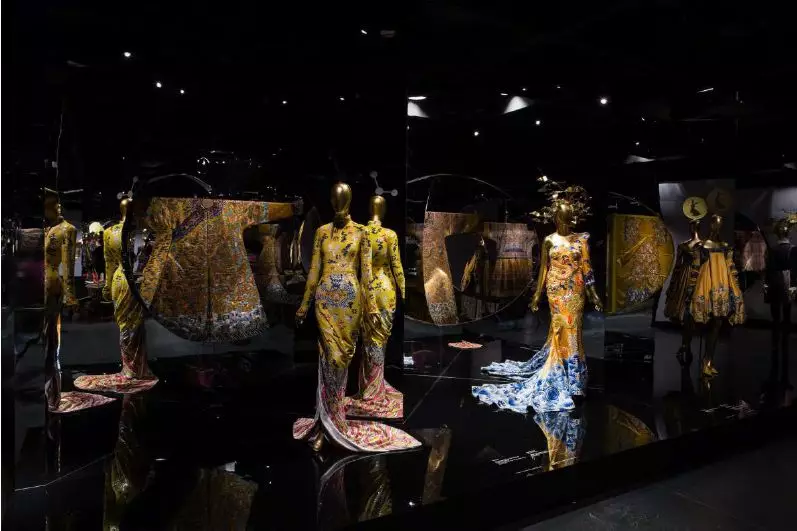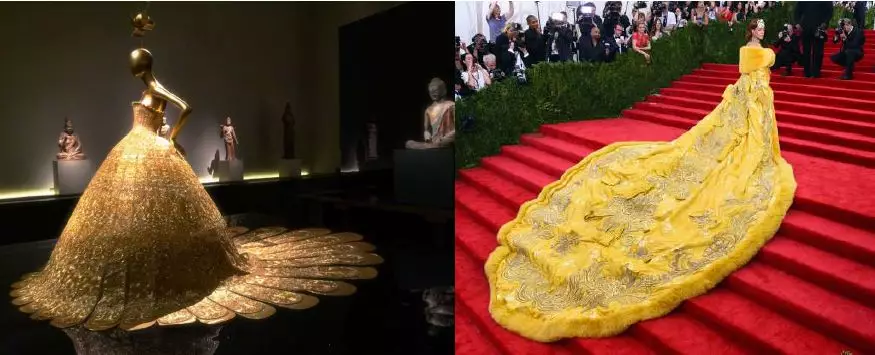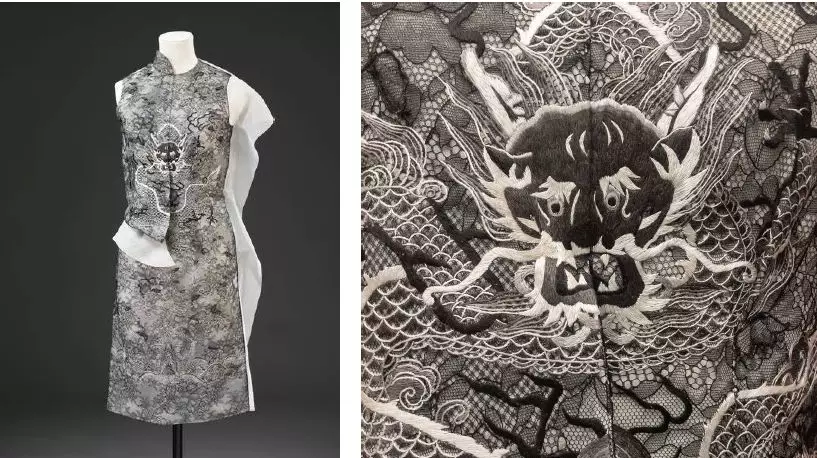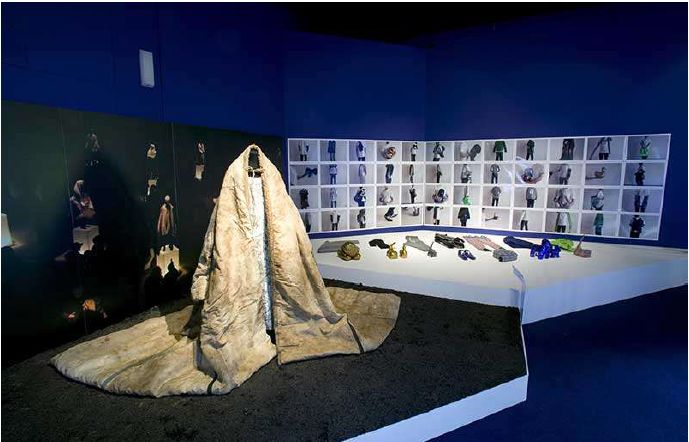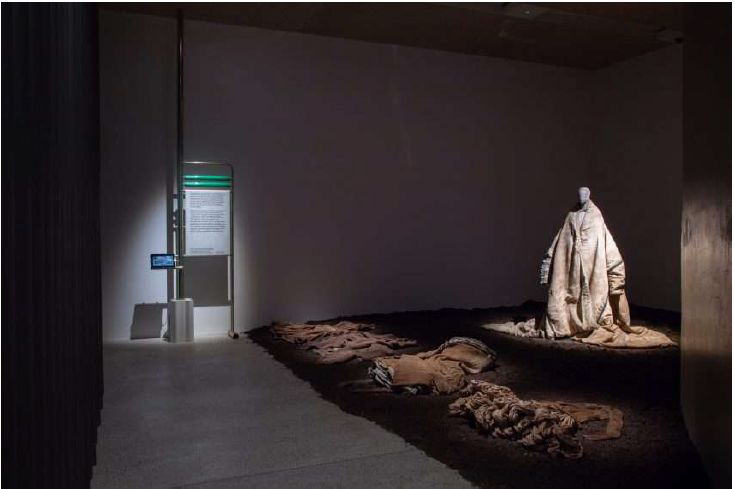The Parkview Museum Beijing invited fashion curator Pooky Lee to launch the public lecture: "Between East and West: A History of Curating Chinese Fashion" on 29th December 2019. In this lecture, Pooky Lee offered a detailed reading and analysis of a few case studies from 20th and 21st century: exhibitions hosted by western museum institutions revolving around collecting and displaying Chinese fashion, as well as China’s own trajectory of dealing with curating fashion locally. Through the lens of fashion concept and museology, the lecture aims to reveal some of the complexities in cultural, political and social exchanges between east and west.
The lecture is one the public education activities held by The Parkview Museum Beijing within the framework of the exhibition "Bridging Asia-Europe 3". The “Bridging Asia- Europe” series of contemporary art exhibitions aim to establish a cultural bridge between countries of the East and the West through the creation of a dialogue between artists within a global and multicultural perspective.
Excerpt from Pooky Lee's speech for the lecture
This particular picture is chosen because of the similarities and differences between the three exhibits. The dress on the left belongs to the American designer Tom Ford's 2004 collection for French fashion house Yves Saint Laurent: one dress wraps around the wearer, emphasizing the curves of the body, with a large yellow embroidered Chinese imperial pattern; on the right, Chinese fashion designer Laurence Xu designed and made the "Oriental auspicious cloud" dress for actress Fan Bingbing at the opening ceremony of the 2010 Cannes Film Festival in France. The same creative logic applies to the tailoring of the western dress and the decorative pattern of the Oriental dragon robe. Behind the two is a late-18th-century Chinese dragon robe from the metropolitan museum of art. The presentation of these three exhibits contributes to explore the position of China and Chinese fashion within the context of globalization.
This image is from the exhibition of Metropolitan Museum of Art's: "China: Through the Looking Mirror" exhibited in 2015. The exhibition was co-organized by the museum's costume institute and the Asian art department, which was then celebrating its centennial. According to the press release, the exhibition aims to show how Chinese aesthetics have influenced western fashion and how the image of China has enriched the imagination of fashion over the centuries.
This exhibition China: Through the Looking Mirror is related to china, or to an imaginary China. It concerns fashion in general and it is not strictly related to Chinese fashion. In this exhibition, only three Chinese fashion designers (including Ms. Lawrence Xu) are presented and therefore the influence of Chinese aesthetics as a topic is explored in a rather superficial way.
Apart from Lawrence Xu, this exhibition also includes Guo Pei, who lives and works in Beijing, and Vivienne Tam, who was born in Guangzhou but moved to New York as a teenager. The former two mainly focus on the creation of advanced customization, with more gorgeous and decorative styles, while the latter is famous in the western fashion circle for incorporating Chinese cultural symbols in his creations and he is one of the representative exponent of the earliest emerging Chinese designers. But in this show, the presentation of works of a Chinese designer has more an aesthetic function. Ms. Guo states that within her 2005 "Samsara" collection, curators chose a dress called "Great Gold," inspired by the sun and the thangka of Chinese Tibetan Buddhism. However, the public was most impressed by how singer Rihanna ended up on the red carpet at the opening ceremony in a huge brocade jacket.
To prove this western-centric approach in the fashion design arena, as mentioned above, Lawrence Xu donated the dress to the Victoria and Albert Museum in London in 2012.The V&A museum is the largest art and design museum in the world, with more than 2.3 million pieces of art and design products spanning 5,000 years of human civilization. Fashion, which is mainly represented by clothes and accessories, also occupies a place in the museum and shows a tendency of rising of importance in recent years. Such a design, however, is housed in the museum's Asian department, not the fashion and textile department. Similarly, Zhang Huishan, a young fashion designer living in London, graduated from the prestigious Central Saint Martins College of Art and Design, majoring in womenswear design. In 2012, he also donated a dress from his 2010 graduation collection to the museum, but it remains in the Asia department and was not included in the fashion and textile department.
In museum’s caption, Zhang Huishan’s dress was described as follow: “The signature design is a cheongsam, a dress often associated with Shanghai in the 1920s. His design blends traditional Chinese culture with western society, with a modern twist. In some academic theories, fashion, as a social and cultural concept, is often interpreted as a representative element of western modernity. Chinese fashion is somehow expected to show the heritage of traditional cultural element to reinforce its Chinese identity, but, at the same time, to break away from the past to show a certain attitude towards modernization.
When we focus on how foreign museums deal with fashion themes, it will be found that they still focus on the fashion trends they are more familiar with. Most of the museum tend to mainly have western fashion both in their collection and in their exhibition. From the middle of the 19th century to the beginning of the 20th century, museums were built in Europe, and ethnic, religious or court dress began to be considered decorative art and incorporated into collections. This is the origin of costume collections at institutions such as the V&A museum in London and the Museum of Decorative Arts in Paris.
The first exhibition on China and fashion was held at the Museum of the Fashion Institute of Technology in New York in 1999. The curator is Valerie Steele, a well-known fashion historian, and her husband John Major, a Chinese historian. Similar to China: looking through the mirror, China Chic also traces the influence of some garments that symbolize China's national identity, such as cheongsam, dragon robe and MAO suit, and how they exert an influence on global fashion creation. The difference is that China Chic focuses more on the relationship between clothing, anthropology and sociology, without touching the sensitive topics of orientalism and colonialism.
Valerie Steele is one of the earliest scholars who traveled and visited china. In the 1980s and 1990s, when the topic was still rather unknown within the academic circles, she already wrote many articles for newspapers, magazines and academic journals, challenging the stereotype according to which there was no fashion in China. The exhibition, in her words, hopes to give to Chinese experts new perspectives for a richer understanding of Chinese culture and society through the lens of fashion; for fashion lovers, the exhibition also aims to break the long-standing European-centric fashion mindset.
With the rapid development of economy and more and more frequent participation in international dialogue, the current situation of Chinese fashion design has become an issue of concern under the global spotlight. In fact, after entering the 21st century, Chinese government policy is also tilting to encourage the transformation and upgrading from ‘made in China’ to ‘designed in China’. As the Washington post reported in 2006: "the success of China's transformation -- from world workshop to cradle of creativity -- is an important factor in shaping the future of this great nation." The same is certainly true for fashion design, which is based on the principles of creativity and self-innovation. Therefore, although it was nine years after the exhibition of China Chic that Chinese fashion formally appeared again in the exhibition of the international museum, the short period of nine years also symbolizes the new exploration of the development of Chinese fashion, and the development of new identity characteristics adapted to The Times from the original tradition.
In 2008, the year of the 30th anniversary of China's reform and opening-up policy and the first Olympic Games to be held in Beijing, The Victoria and Albert museum has launched "China Design Now" from March, an exhibition that attempts to break down the urban themes and, for the first time, carefully tease out the prominence of Chinese design in recent years. Although the exhibition is a comprehensive exhibition rather than a fashion exhibition, several fashion designers -- Han Feng, Lu Kun, Ma Ke, Wang Yiyang and Zhang Da -- had the opportunity to showcase representative works in Shanghai's urban section. The designers share a more cohesive identity which shows influence by 1980s and 1990s Japanese and Belgian fashion design. Their works are focused on exploring personal identity expression, trying to strike a delicate balance between concept and technology. However, the exhibition also reinforces the inaccurate perception that Chinese fashion as associated with Shanghai fashion.
At the same time in New York, Chinese and Asian fashion designers are quietly popular. The American fashion industry has a close relationship with Chinese workers, especially with early Chinese immigrants. It was a group of people who first established themselves in a foreign land by working in the garment district of New York. However, if Vivienne Tam and Vera Wang are the early Chinese fashion designers who worked hard to establish their careers in the 1990s, from 2010 on, the second generation of Chinese designers represented by Alexander Wang, Jason Wu and Philip Lim begins to emerge on the national stage and international stage, and were regarded as the hope of new design. In 2010, Richard Chai, Jason Wu and Alexander Wang respectively won ‘designer of the year’ awards for men's wear, women's wear and accessories at the council of fashion designers of America awards, which has the fashion industry's Oscars. Outside the industry, the story of Jason Wu's design for then-president Barack Obama's wife, Michelle Obama, also reinforced the credibility of Chinese-American design and challenged many of the stereotypes that have long been associated with the Chinese-American community.
The word China or Chinese we are talking about refers more to the same cultural origin rather than the political and geographical distinction. Regardless, the "Front Row" exhibition in New York in 2013 was the first exhibition dedicated to the achievements of these Chinese fashion designers. The exhibition is co-curated by Mary Ping, who is also a Chinese designer, and the venue is the Chinese American Museum.
Fashion is a highly Western-centric industry, with four major fashion weeks-New York, London, Milan, Paris-as the industry's weathervane. But in a highly globalized world, such a western centric approach becomes somewhat outdated. In 2015, in order to break away from this approach and to challenge the hegemony of the four major capitals in the traditional fashion arena, the Museum of the American Institute of Fashion Technology also held an exhibition called the Global Fashion Capital with an emphasis to the new generation of fashion designers in various countries, regions and cultural backgrounds around the world. The picture shows two designers from Shanghai: Uma Wang and Masha Ma, the former is one of the current designers supported by Valerie Steele, supervisor of FIT Museum. Steele not only attends Uma Wang's press conference during Paris Fashion Week every quarter, and during a lecture in Shanghai last March, she also specifically visited Uma Wang's Shanghai stores to purchase new clothes for herself. A similar approach is the exhibition "The Future of fashion is now" organized by the Boijmans Van Berningen Museum in the Netherlands, and includes many Chinese fashion design students' works. The exhibition also toured to Shenzhen, and other places in China.
As discussed earlier, the global perspective's curiosity and attention to Chinese fashion is focused on the expectation that fashion designers from China can bring new creative ideas, both in terms of production and concept. Chinese designer Marco is one of the few people who can meet such requirements: the ‘useless’ series of haute couture brands that was presented in 2016 at the London Design Museum exhibition Fear and Love, was more like an art installation.
For most Chinese museums, it is not easy to acknowledge the value of fashion academic research and integrate it into the long-term program planning of the museum, with the exception of the Hangzhou Silk Museum. There are many reasons for this, such as lack of clothing collections, the difficulty in sourcing an appropriate fashion curatorial team, but, more importantly, the fact that most organizations still have prejudices about fashion and tend to consider it superficial, exravagant, etc. However, the fashion curatorial projects of leading museum institutions around the world, and the fashion academic research that has emerged since the late 1970s, have long proved that such negative stereotypes do not have a conceptual basis.
At the government level, fashion design is not a category of Chinese creative design that deserves international promotion. This is different from a country like France with a long history of fashion. Fashion, as well as the curatorial activity focusing on the exhibition of national boutique clothing design, have become one of France's most important assets when it comes the national promotion worldwide. In China, many exhibitions of French designers were organized: Yves Saint Laurent's solo exhibition at the China Art Museum in Beijing in 1985, the Paris Fashion Art Museum collection exhibition at the Shanghai Art Museum in 1989, and French fashion designer Christian Lacroix at the China Art Museum in Beijing in 2004 Solo exhibition "Cristian Laqua: Dialogue", "100 Years of French Fashion" held by the National Museum of China, etc. The organizers are supported by the French Ministry of Culture and the Ministry of Foreign Affairs within the framework of diplomatic activities such as the Chinese-French Cultural Year section.
As art critic Richard Dorment wrote in the 2008 “Dior and Chinese Artist” exhibition review for the British Telegraph in 2008: "Fashion affects not only our dress but also our way of thinking. If you want to learn about a country's attitude towards modernity or class style, don't ask art critics, look through fashion magazines. "
The Parkview Museum Beijing has long been committed to establish a platform for the public for art appreciation and cultural exchanges and it regularly organizes cultural activities. You are welcomed to participate and register.

